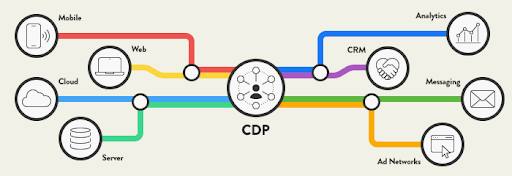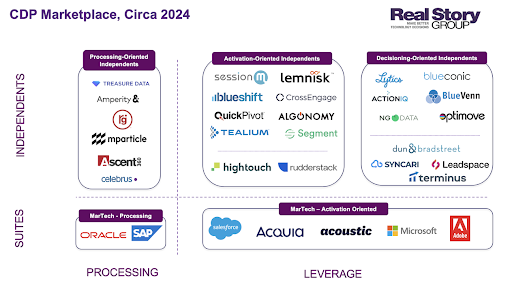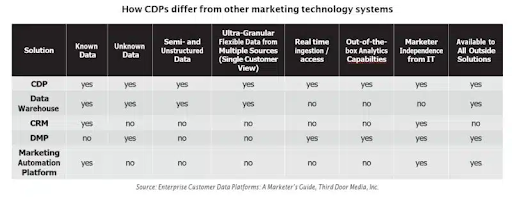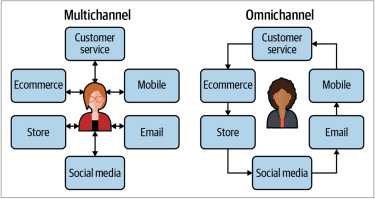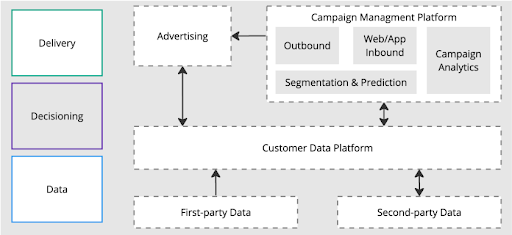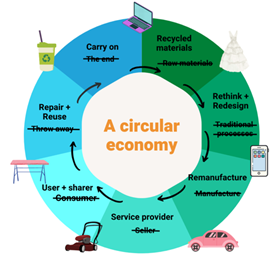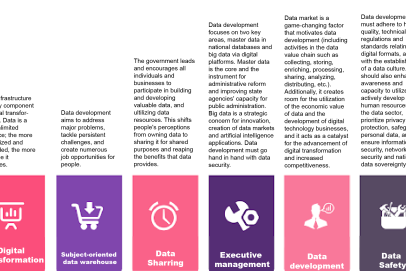Implementing Enterprise CDP – what decision makers should know?
1. A Brief Introduction of CDP
1.1. What is CDP?
The “CDP phenomenon” began in 2016 in the United States, quickly becoming a technological trend with high expectations of transforming the Martech industry globally. CDPs are anticipated to replace DMPs, the declining star of Adtech.
A CDP (Customer Data Platform) provides three core features that make it unique from other systems.
- A unified, persistent customer database that provides data transparency and granularity at the known, individual level. A CDP can identify customers from many different data sources by stitching together information under a unique, individual identifier. The CDP then stores its own copy of the data.
- Control over customer data collection, segmentation and orchestration through native (out-of- the-box) integration that minimizes the need for IT or developer involvement.
- Data integration of both known and anonymous customer data with any external source or platform, including CRM, point of sale (POS), mobile, transactional, website, email and marketing automation.
CDPs serve as systems of record, consolidating customer profiles in a central repository. This data is accessible for marketing analysis, segmentation, and insight discovery, enhancing the efficiency and effectiveness of omnichannel marketing campaigns.
The CDP Institute’s definition of a “RealCDP” requires it be able to do the following five things:
- Ingest real-time data from any source.
- Capture full detail of ingested data.
- Store ingested data indefinitely (subject to privacy constraints).
- Create unified profiles of identified individuals.
- Share data with any system that needs it.
(Parker, Pamela. “What is a CDP and how does it give marketers the coveted ‘single view’ of their customers?”, 2023)
1.2. CDP Market in Vietnam
The CDP market in Vietnam began to thrive around late 2010 to early 2011, thanks to industry veterans like Minh Lava (Minh Ng), Dat Antsomi (Dinh Le Dat), and Trieu PrimeData (Nguyen Hai Trieu). Some CDPs or near-CDPs made in Vietnam, such as Antsomi, PrimeData, and Mobio, were well-invested from the start. Others were developed by combining various data, reporting, and delivery solutions, leveraging platforms like Azure and AWS to address different customer challenges.
The real CDP trend has been observed for nearly four years, marking its significant impact since November 2019. Here’s a look back at the key points of this trend:
Major Players in Enterprise CDP Solutions
- Salesforce Data Cloud: Launched in 2019, this solution was developed from scratch despite Salesforce’s existing robust platforms in reporting, platform, and marketing.
- Oracle Cx Unity: Introduced in 2018, it leverages the Oracle Fusion Cx platform and abundant third-party data from Oracle Data Cloud, recently renamed Oracle Advertising.
- SAP’s CDP: Developed from the Gigya solution specializing in CIAM since 2017, it focuses on deeply integrating customer data with ERP data.
- Microsoft Dynamic 365 Customer Insights: This solution combines various ecosystem tools such as MS Marketing, PowerBI, and machine learning support on Azure.
- Adobe Real-time CDP: Launched to enhance the Experience Cloud, providing a perfectly integrated platform with Adobe’s other solutions.
As of 2024, the above graphic shows the major players CDP providers in the market worldwide.
Strengths and Weaknesses of Enterprise CDPs
Strengths:
- Rapid Growth: These solutions benefit from abundant financial resources, facilitating swift development.
- Ecosystem Integration: Being part of a larger ecosystem allows for excellent synergy and integration.
Weaknesses:
CDP’s weaknesses stem from theit vastly different orientations.
- Salesforce Data Cloud: Primarily targets customers already using its other solutions.
- Oracle: Has recently shifted its focus away from the APAC market towards more mature markets like the US and Europe.
- SAP: Although leading in ERP, it is a young player in CRM/Cx/Customer Data. It promotes the message “CDP is not just for Marketing,” aiming to use CDP for various functions.
- Microsoft: Sells Dynamics mainly through partners without direct Field Sales, resulting in limited presence in Vietnam.
- Adobe: Does not have Field Sales in Vietnam and considers it a non-key market due to the high costs of its solutions.
- Purpose-Built CDPs: other solutions like AgilOne, Treasure Data, and Redpoint Global, while famous globally, are not present in Vietnam due to cost constraints.
2. Common Mistakes Enterprises Make When Adopting CDP
The adoption of Customer Data Platforms (CDPs) has become increasingly popular as enterprises seek to unify customer data and enhance marketing efforts. However, the implementation of CDPs often comes with a set of challenges and common mistakes that can lead to unsuccessful projects. The following explores these pitfalls and offers insights into how to avoid them.
2.1. Never mistake DMP with CDP
As we enter the cookie-less era of 2024, Customer Data Platforms (CDPs) are more crucial than ever. With third-party cookies fading out, businesses are scrambling to collect and manage their own customer data effectively. CDPs provide the perfect solution, unifying data from various sources, enriching it, and allowing for targeted marketing and personalized experiences.
(Krishnan, Anish. https://www.linkedin.com/posts/anishkrishnan8_keytrends-cdp-community-activity-7147888893491662848-jLI2, 2024)
One significant pain point in this transition is the disabling of Data Management Platforms (DMPs). DMPs heavily relied on third-party cookies to track user behavior across different websites, creating audience segments for targeted advertising. Without cookies, DMPs struggle to maintain their functionality, leading to a decline in their effectiveness and relevance.
Data Management Platforms (DMPs) focus on third-party data, offering enhanced targeting, campaign optimization, and data monetization. Despite their advantages, DMPs face challenges like privacy concerns, data decay, and limited customer insights.
Customer Data Platforms (CDPs), on the other hand, unify first-party data collected directly from customers through interactions, email signups, purchase history, and loyalty programs. CDPs provide a holistic view of the customer base, offering features such as a unified customer database, control over data collection and segmentation, and data integration with various external sources.
2.1.2. Key Differences Between DMP and CDP
- Data Source: DMPs leverage third-party data, while CDPs focus on first-party data.
- Customer Focus: DMPs create audience segments, whereas CDPs build unified customer profiles.
- Use Cases: DMPs primarily support advertising, while CDPs empower a wider range of marketing initiatives, including personalization, customer segmentation, and lifecycle marketing.
2.1.3. Why the Move from DMP to CDP?
- Customer-Centricity: CDPs enable a customer-centric approach by focusing on known customer data, allowing businesses to create personalized experiences and build long-term customer relationships.
- Regulatory Compliance: CDPs offer better compliance with data privacy regulations by focusing on first-party data and providing transparency and control to customers over their data.
- Data Quality and Integration: CDPs emphasize data quality and integration, ensuring that businesses have a complete and accurate view of their customers across channels and touchpoints.
- Holistic Insights: CDPs provide deeper insights into customer behavior, preferences, and interactions, empowering businesses to make data-driven decisions and drive revenue growth.
2.2. The idea of DWH as a CDP
Cloud-based data warehouses (DWHs) have revolutionized data storage and processing, bringing simpler deployment, greater scale, and better performance to data-driven use cases. They have become more prevalent in enterprise tech stacks, including Martech stacks. This raises the question: Should you employ your existing DWH as a CDP?
While reusing an existing DWH for CDP purposes might seem resource-efficient, it comes with several inherent problems:
- Lack of Marketer-Friendly Access: Enterprise DWHs are typically constructed to support analytics use cases, not activation use cases. Data is stored in database tables with column names as attributes, requiring complex SQL statements to access. This setup is not user-friendly for marketers who need to create segments for activation.
- Real-Time Limitations: DWHs aren’t designed to support real-time marketing use cases that many CDPs target. While they can perform quick calculations and schedule frequent data processing, they are not truly real-time. Marketers often need real-time data to trigger certain activations.
- Missing Capabilities: Most CDPs offer additional capabilities such as event subsystems with triggering, anonymous identity resolution, marketer-friendly interfaces for segmentation, and segment activation profiles with connectors. A DWH alone does not provide these features, necessitating additional integrations and support efforts.
The below table give us the boardest view on how CDPs differ from other marketing technology systems.
2.3. Some other Mistakes in CDP Adoption
- Overblown Expectations: Early discussions about CDPs often involved abstract, technical jargon and acronyms that led to unrealistic expectations. Terms like core engine, DSP/DMP, AI/ML, personalization, and prediction created misconceptions about CDP capabilities.
- Top-Down Implementation: In large companies, CDP implementation often follows a top-down approach. CMOs focus on branding without understanding performance metrics, while CTOs/CIOs, who may lack practical business experience, often rely on vendor relationships rather than practical solutions.
- Internal Miscommunication: The e-commerce team, which benefits most from CDPs, often receives insufficient support and faces unrealistic demands from higher management. This disconnect leads to inefficiency and stagnation.
- Technical Dependencies: Customizing CDP solutions frequently requires tech team involvement, leading to delays and inefficiencies due to unclear instructions and dependencies.
- Unrealistic Promises: To achieve sales targets, CDP providers often make exaggerated promises, committing to metrics beyond their capabilities. This results in failed implementations and damaged reputations for both the business and the CDP provider.
3. The right way to adopt CDP: right data – right tool – right channel
3.1. The Right Data
A CDP is only as good as the data it collects. To maximize the benefits of your CDP, it is crucial to integrate all your data sources, including CRM systems, social media platforms, and website analytics tools. This integration process can be complex, but many CDP providers offer seamless integrations to simplify the task. Before leveraging your CDP, it’s essential to clean and enrich your data. This involves removing duplicates, standardizing data fields, and filling in missing information. Additionally, enhancing your data with demographic or behavioral insights from third-party sources can provide a more comprehensive customer view. Once your data is clean and enriched, you can analyze and segment it, identifying patterns and trends in customer behavior. This segmentation allows for targeted marketing campaigns and personalized customer interactions. Expertise in data management, analytics, and reporting is critical for this process, requiring talent well-versed in data architecture, database design, and data quality management. Companies with mature data infrastructure and a robust data management culture are better positioned to successfully implement a CDP, while those with less developed data practices may need to focus on building a strong data foundation first.
3.2. The Right Tool
When selecting an appropriate CDP technology, several key points should be considered:
- Compliance: Ensure the technology accounts for solutions complying with Decree 13 on personal data protection, Decree 53 on cybersecurity, and data localization requirements within Vietnam.
- Data Collection & Integration Capabilities: The system should support schema-less data integration, various data formats, and multiple connectors to different systems. It should offer real-time processing, ready and native integration with CMP solutions, low customization needs, and minimal IT dependency during use. Support for both PULL and PUSH data mechanisms into the Treasure Data system is also crucial.
- Customer Identification & Profile Unification: The technology should identify customers using both absolute and relative mapping methods, leveraging multiple customer IDs for identification. Real-time customer identification and profile unification across multiple channels and platforms are a plus.
- Data Management & Customer Data Governance: The system should be open, allowing integration with other operational systems for managing and governing customer data. It should automatically identify and manage data based on metadata/data dictionaries. A data plan should enable users to design standardization, collection, and transformation rules within the CDP’s UI, with options to block or quarantine data to ensure data quality. The system must support hashing/encryption of PII data during and after import, allow column-level data access permissions, and provide reporting data exports via file or API. There should be no limit on the number of attributes for a customer profile.
- Technical Features in AI/ML & Analytics: Real-time customer segmentation, rule-based/trigger-based/event-based segmentation via the UI, and advanced segmentation using AI/ML model results with custom scripts should be supported. Created segments should be usable for real-time marketing scenarios across various channels/platforms. Customer journeys should be configurable within the CDP’s UI, supporting unlimited segments and integration with custom-developed machine learning models.
3.3. The Right Channel
A Customer Data Platform (CDP) should be seen as a marketer’s best friend. Designed specifically for marketers and sales teams, a CDP is an invaluable tool for creating engaging, personalized customer journeys that foster customer loyalty and drive sales. In the modern marketing landscape, delivering the right message through the right channel at the right time is paramount for successful customer engagement. Customer Data Platforms (CDPs) excel in this area by providing the tools necessary for effective cross-channel orchestration.
Omnichannel Approach
Earlier marketing technologies couldn’t handle the wide range of today’s devices and channels. They mainly focused on fixed email offers, like a promotion valid online or in stores, but not both. Now, an omnichannel approach is crucial because consumers use many different channels before buying. Without it, tracking and understanding these interactions is nearly impossible. CDPs help marketers leverage multiple channels, including email, SMS, mobile push notifications, in-app messaging, and social media, to reach customers where they are most active. The below figure shows the difference between multichannel and omnichannel marketing.
(Wood, Karen. “A CDP Guide for CMOs”, 2022)
Moreover, an omnichannel strategy facilitated by a CDP enhances marketing attribution by providing a holistic view of how different touchpoints contribute to conversions, allows for seamless customer experiences, enabling marketers to create consistent and personalized journeys across all touchpoints. This comprehensive insight allows marketers to fine-tune their strategies, optimizing campaigns for better engagement and higher return on investment. Ultimately, by leveraging the right channels through a CDP, businesses can ensure that their marketing efforts are both effective and efficient, driving customer acquisition, retention, and loyalty.
Adopting Marketing Automation
In the context of marketing automation, CDPs significantly enhance the capabilities of traditional Marketing Automation Systems (MAS). Unlike legacy technologies that rely on predefined guidelines, CDPs use powerful AI-based algorithms to deliver superior outcomes. These advanced capabilities enable real-time campaign activation, hyper-personalized interactions, and seamless omnichannel marketing, making CDPs indispensable for modern marketing strategies. By integrating a CDP with your MAS, you can achieve higher efficiency, better customer engagement, and substantial ROI, setting a new benchmark in marketing automation.
Components of a seamless CDP integration
The integration of a Campaign Management Platform with a Customer Data Platform could be the answer to a seamless CDP integration. CMP enables marketers to utilize rich customer insights for more effective segmentation, targeted campaigns, and personalized customer interactions. This synergy enhances overall marketing efficiency and customer engagement by ensuring that the right messages are delivered through the right channels at the right times.
- Data Integration: The CDP collects first-party and second-party data to build comprehensive customer profiles. This data is then fed into the Campaign Management Platform.
- Decisioning: The decisioning component in the system uses the data and segmentation insights to determine the best marketing actions, optimizing the customer journey and improving engagement.
- Delivery: Finally, the delivery mechanism ensures that marketing messages are sent out through the appropriate channels, whether it’s advertising, direct communication, or app notifications.
Campaign Management Platform
- Outbound Campaigns: The CMP uses the segmented data from the CDP to execute outbound campaigns, such as email marketing, SMS, and other direct communication channels.
- Web/App Inbound: The CMP also manages inbound interactions through web and mobile applications, ensuring that customer engagement is personalized and relevant based on the CDP’s insights.
- Segmentation & Prediction: Within the CMP, segmentation and predictive analytics leverage the rich customer data provided by the CDP to identify target audiences and predict customer behaviors.
- Campaign Analytics: The CMP provides analytics on campaign performance, feeding this back into the CDP to refine customer profiles and improve future campaigns. This creates a continuous feedback loop that enhances marketing strategies over time.
Advertising
The advertising function within the CMP uses customer insights from the CDP to tailor advertisements, ensuring they are relevant and personalized, thus improving their effectiveness and reducing ad spend wastage.
4. A few words of closing on CDP
Implementing a Customer Data Platform (CDP) is essential for unifying customer data and enhancing marketing strategies. CDPs offer real-time insights and comprehensive profiles, crucial in the upcoming cookie-less era.
The CDP market is growing, but success requires avoiding pitfalls like unrealistic expectations and poor communication. Choosing the right technology and focusing on data quality and integration are key.
Effective use of CDPs improves marketing efficiency and customer engagement, driving personalized, data-driven experiences. CDPs are pivotal for consistent interactions across all touchpoints, ensuring business growth and customer loyalty.
| Exlusive article by FPT IS expert
Author Le Viet Thanh – Deputy Director of Data Analysis and Platform Center |


